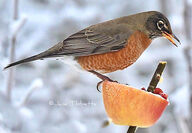Sorted by date Results 1 - 9 of 9

Picture this: A chickadee lands on your carefully crafted pinecone feeder, coated with peanut butter or suet and seeds. You're feeling good about helping local wildlife. But wait! There's a catch here. Feathers are more than beautiful-they're an essential survival tool. Their intricate structure includes thousands of tiny barbs that lock together to form a waterproof shield and provide insulation. They are an engineering masterpiece that makes NASA jealous! In winter, down... Full story

Remarkably, hummingbirds overwinter in Central Oregon. These toughies are Anna's hummingbirds and are amazingly stout for their 4- to 4.5-gram size. They have expanded their range into hotter and colder climates over the last 20 years. But they face real trouble in deep freeze, blizzard conditions, and icy rain. Local residents can help them survive. Due to their petite size, hummingbirds must feed every 10 to 15 minutes or starve. These quaint birds use a handy... Full story

As Halloween approaches, neighborhoods across Central Oregon will soon be adorned with festive, spooky decorations. From the eerie glow of jack-o'-lanterns to cobweb-draped porches, this whimsical holiday is celebrated through creative displays. Our spirited designs don't stop on October 31; they transition into joyful fall and winter holiday décor. However, there is a frightening side to some of our fun adornments. From nimble chickadees to graceful deer, wildlife can be... Full story

The outside thermometer has launched into the red zone. We know that heat can have concerning health impacts, but not just for us upright two-leggeds. Everyone suffers in extreme heat — insects, mammals, and birds, as well as those with roots holding them in one place, plants. The animals and plants of Central Oregon are adapted to some heat extremes. But last year, we beat all records when we catapulted up into the triple digits of 115 degrees. And here we are again in... Full story

Elise Wolf, a bird rehabber in Sisters, my wife Sue, and I have fed birds year-round because of the pleasure it brings us seeing winged creatures up close, and knowing with our help they — and we — can make it through some pretty tough times when birds are part of our lives. So here are a few tips to ensure safe feeding practices: To have the reserves to survive winter’s frigid temperatures, birds need to eat foods that are easiest to eat and digest, and that pack... Full story
It’s baby bird season! Some babies are already popping out of nests, fluttering after parents making sweet little “feed me” calls. Yet baby birds face a gauntlet of risks, and it’s why many do not make it to adulthood. Knowing when to rescue a baby bird can be super confusing. The internet abounds with poor and misinformed advice. What’s worse are the infographic flow charts that oversimplify young birds. One hundred and ninety species of birds nest in Central Oregon. When a young bird leaves the nest (fledges) – a... Full story

Spring is here! Well, sort of. Central Oregon always seems to unleash more cold and even snowy days on us this time of year. Yet, still, the trees are budding out, and the bright greens of waking plants are appearing. Our avian friends, both the residents and the snowbirds returning from their warmer winter haunts, are restless. This is the season birds begin the most important job they’ll have in their lives — making babies. Over the late winter and spring months, b... Full story

“One cannot think well, love well, sleep well, if one has not dined well.” So said Virginia Woolf. These words could not be more valid than for birds. Our flighted friends are essentially Olympic athletes. Their foods should be of a quality to allow them to thrive, not just survive. So, let’s explore bird food! Sunflower seeds: At 50 percent fat and 24 percent protein, black oil sunflower seeds are greedily consumed. In fact, a sunflower seed beats a mealworm in protein conten... Full story
Across the country, small, striped brown birds with flashy hints of yellow are swarming bird feeders. These delightful birds are pine siskins. Since October of 2020, the tiny finches have streamed south by the thousands in a record-breaking migration event. In one sighting, birders counted a cloud of over 5,000 in October in Cape May, New Jersey. The pine siskins are not alone; evening grosbeaks, common redpoll, Cassin’s finch, red crossbill, and even red-breasted nuthatch have abandoned the north because the cone crop is l... Full story